SuBeen Lee
White Aggregation and Restoration for Few-shot 3D Point Cloud Semantic Segmentation
Sep 17, 2025Abstract:Few-Shot 3D Point Cloud Segmentation (FS-PCS) aims to predict per-point labels for an unlabeled point cloud, given only a few labeled examples. To extract discriminative representations from the limited support set, existing methods have constructed prototypes using conventional algorithms such as farthest point sampling. However, we point out that its initial randomness significantly affects FS-PCS performance and that the prototype generation process remains underexplored despite its prevalence. This motivates us to investigate an advanced prototype generation method based on attention mechanism. Despite its potential, we found that vanilla module suffers from the distributional gap between learnable prototypical tokens and support features. To overcome this, we propose White Aggregation and Restoration Module (WARM), which resolves the misalignment by sandwiching cross-attention between whitening and coloring transformations. Specifically, whitening aligns the support features to prototypical tokens before attention process, and subsequently coloring restores the original distribution to the attended tokens. This simple yet effective design enables robust attention, thereby generating representative prototypes by capturing the semantic relationships among support features. Our method achieves state-of-the-art performance with a significant margin on multiple FS-PCS benchmarks, demonstrating its effectiveness through extensive experiments.
Temporal Alignment-Free Video Matching for Few-shot Action Recognition
Apr 08, 2025



Abstract:Few-Shot Action Recognition (FSAR) aims to train a model with only a few labeled video instances. A key challenge in FSAR is handling divergent narrative trajectories for precise video matching. While the frame- and tuple-level alignment approaches have been promising, their methods heavily rely on pre-defined and length-dependent alignment units (e.g., frames or tuples), which limits flexibility for actions of varying lengths and speeds. In this work, we introduce a novel TEmporal Alignment-free Matching (TEAM) approach, which eliminates the need for temporal units in action representation and brute-force alignment during matching. Specifically, TEAM represents each video with a fixed set of pattern tokens that capture globally discriminative clues within the video instance regardless of action length or speed, ensuring its flexibility. Furthermore, TEAM is inherently efficient, using token-wise comparisons to measure similarity between videos, unlike existing methods that rely on pairwise comparisons for temporal alignment. Additionally, we propose an adaptation process that identifies and removes common information across classes, establishing clear boundaries even between novel categories. Extensive experiments demonstrate the effectiveness of TEAM. Codes are available at github.com/leesb7426/TEAM.
Foreground-Covering Prototype Generation and Matching for SAM-Aided Few-Shot Segmentation
Jan 01, 2025


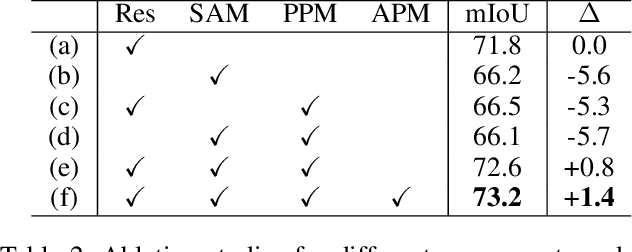
Abstract:We propose Foreground-Covering Prototype Generation and Matching to resolve Few-Shot Segmentation (FSS), which aims to segment target regions in unlabeled query images based on labeled support images. Unlike previous research, which typically estimates target regions in the query using support prototypes and query pixels, we utilize the relationship between support and query prototypes. To achieve this, we utilize two complementary features: SAM Image Encoder features for pixel aggregation and ResNet features for class consistency. Specifically, we construct support and query prototypes with SAM features and distinguish query prototypes of target regions based on ResNet features. For the query prototype construction, we begin by roughly guiding foreground regions within SAM features using the conventional pseudo-mask, then employ iterative cross-attention to aggregate foreground features into learnable tokens. Here, we discover that the cross-attention weights can effectively alternate the conventional pseudo-mask. Therefore, we use the attention-based pseudo-mask to guide ResNet features to focus on the foreground, then infuse the guided ResNet feature into the learnable tokens to generate class-consistent query prototypes. The generation of the support prototype is conducted symmetrically to that of the query one, with the pseudo-mask replaced by the ground-truth mask. Finally, we compare these query prototypes with support ones to generate prompts, which subsequently produce object masks through the SAM Mask Decoder. Our state-of-the-art performances on various datasets validate the effectiveness of the proposed method for FSS. Our official code is available at https://github.com/SuhoPark0706/FCP
Progressive Proxy Anchor Propagation for Unsupervised Semantic Segmentation
Jul 17, 2024
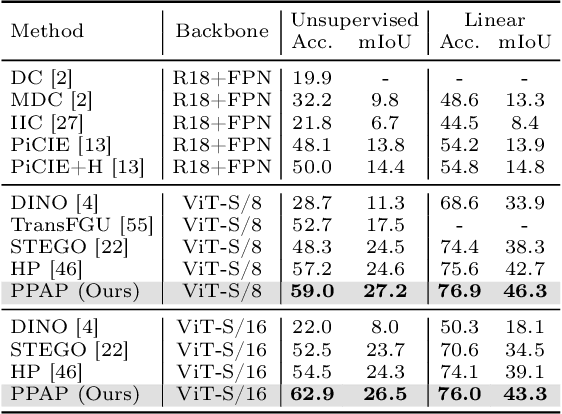
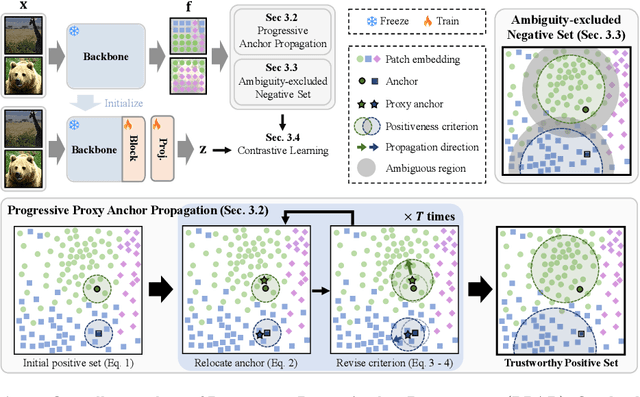
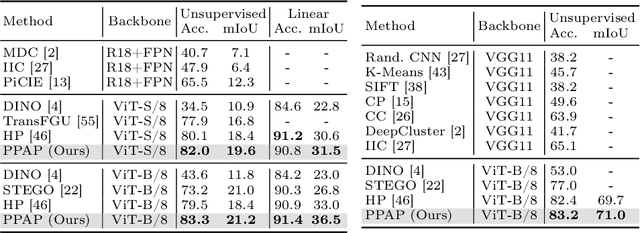
Abstract:The labor-intensive labeling for semantic segmentation has spurred the emergence of Unsupervised Semantic Segmentation. Recent studies utilize patch-wise contrastive learning based on features from image-level self-supervised pretrained models. However, relying solely on similarity-based supervision from image-level pretrained models often leads to unreliable guidance due to insufficient patch-level semantic representations. To address this, we propose a Progressive Proxy Anchor Propagation (PPAP) strategy. This method gradually identifies more trustworthy positives for each anchor by relocating its proxy to regions densely populated with semantically similar samples. Specifically, we initially establish a tight boundary to gather a few reliable positive samples around each anchor. Then, considering the distribution of positive samples, we relocate the proxy anchor towards areas with a higher concentration of positives and adjust the positiveness boundary based on the propagation degree of the proxy anchor. Moreover, to account for ambiguous regions where positive and negative samples may coexist near the positiveness boundary, we introduce an instance-wise ambiguous zone. Samples within these zones are excluded from the negative set, further enhancing the reliability of the negative set. Our state-of-the-art performances on various datasets validate the effectiveness of the proposed method for Unsupervised Semantic Segmentation.
Mitigating Background Shift in Class-Incremental Semantic Segmentation
Jul 16, 2024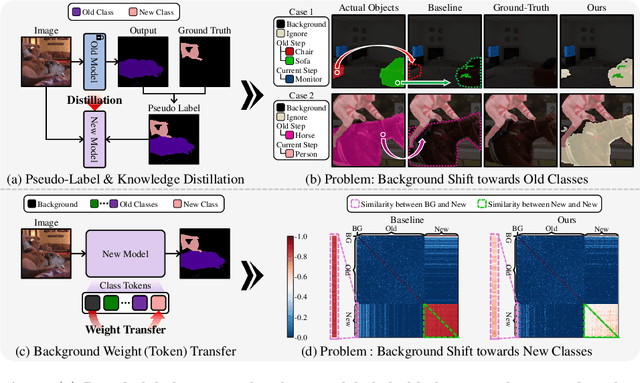
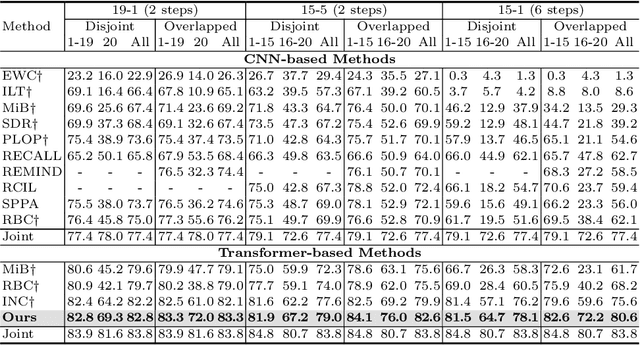
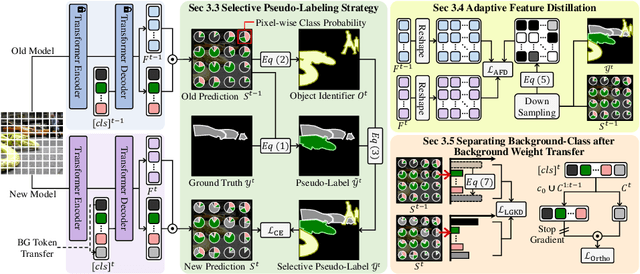
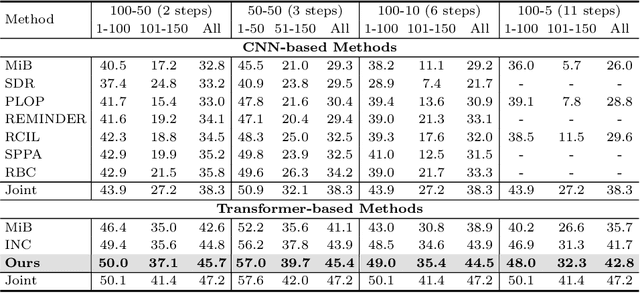
Abstract:Class-Incremental Semantic Segmentation(CISS) aims to learn new classes without forgetting the old ones, using only the labels of the new classes. To achieve this, two popular strategies are employed: 1) pseudo-labeling and knowledge distillation to preserve prior knowledge; and 2) background weight transfer, which leverages the broad coverage of background in learning new classes by transferring background weight to the new class classifier. However, the first strategy heavily relies on the old model in detecting old classes while undetected pixels are regarded as the background, thereby leading to the background shift towards the old classes(i.e., misclassification of old class as background). Additionally, in the case of the second approach, initializing the new class classifier with background knowledge triggers a similar background shift issue, but towards the new classes. To address these issues, we propose a background-class separation framework for CISS. To begin with, selective pseudo-labeling and adaptive feature distillation are to distill only trustworthy past knowledge. On the other hand, we encourage the separation between the background and new classes with a novel orthogonal objective along with label-guided output distillation. Our state-of-the-art results validate the effectiveness of these proposed methods.
Task-Disruptive Background Suppression for Few-Shot Segmentation
Dec 26, 2023Abstract:Few-shot segmentation aims to accurately segment novel target objects within query images using only a limited number of annotated support images. The recent works exploit support background as well as its foreground to precisely compute the dense correlations between query and support. However, they overlook the characteristics of the background that generally contains various types of objects. In this paper, we highlight this characteristic of background which can bring problematic cases as follows: (1) when the query and support backgrounds are dissimilar and (2) when objects in the support background are similar to the target object in the query. Without any consideration of the above cases, adopting the entire support background leads to a misprediction of the query foreground as background. To address this issue, we propose Task-disruptive Background Suppression (TBS), a module to suppress those disruptive support background features based on two spatial-wise scores: query-relevant and target-relevant scores. The former aims to mitigate the impact of unshared features solely existing in the support background, while the latter aims to reduce the influence of target-similar support background features. Based on these two scores, we define a query background relevant score that captures the similarity between the backgrounds of the query and the support, and utilize it to scale support background features to adaptively restrict the impact of disruptive support backgrounds. Our proposed method achieves state-of-the-art performance on PASCAL-5 and COCO-20 datasets on 1-shot segmentation. Our official code is available at github.com/SuhoPark0706/TBSNet.
Correlation-guided Query-Dependency Calibration in Video Representation Learning for Temporal Grounding
Nov 18, 2023



Abstract:Recent endeavors in video temporal grounding enforce strong cross-modal interactions through attention mechanisms to overcome the modality gap between video and text query. However, previous works treat all video clips equally regardless of their semantic relevance with the text query in attention modules. In this paper, our goal is to provide clues for query-associated video clips within the crossmodal encoding process. With our Correlation-Guided Detection Transformer~(CG-DETR), we explore the appropriate clip-wise degree of cross-modal interactions and how to exploit such degrees for prediction. First, we design an adaptive cross-attention layer with dummy tokens. Dummy tokens conditioned by text query take a portion of the attention weights, preventing irrelevant video clips from being represented by the text query. Yet, not all word tokens equally inherit the text query's correlation to video clips. Thus, we further guide the cross-attention map by inferring the fine-grained correlation between video clips and words. We enable this by learning a joint embedding space for high-level concepts, i.e., moment and sentence level, and inferring the clip-word correlation. Lastly, we use a moment-adaptive saliency detector to exploit each video clip's degrees of text engagement. We validate the superiority of CG-DETR with the state-of-the-art results on various benchmarks for both moment retrieval and highlight detection. Codes are available at https://github.com/wjun0830/CGDETR.
Task-Oriented Channel Attention for Fine-Grained Few-Shot Classification
Jul 28, 2023Abstract:The difficulty of the fine-grained image classification mainly comes from a shared overall appearance across classes. Thus, recognizing discriminative details, such as eyes and beaks for birds, is a key in the task. However, this is particularly challenging when training data is limited. To address this, we propose Task Discrepancy Maximization (TDM), a task-oriented channel attention method tailored for fine-grained few-shot classification with two novel modules Support Attention Module (SAM) and Query Attention Module (QAM). SAM highlights channels encoding class-wise discriminative features, while QAM assigns higher weights to object-relevant channels of the query. Based on these submodules, TDM produces task-adaptive features by focusing on channels encoding class-discriminative details and possessed by the query at the same time, for accurate class-sensitive similarity measure between support and query instances. While TDM influences high-level feature maps by task-adaptive calibration of channel-wise importance, we further introduce Instance Attention Module (IAM) operating in intermediate layers of feature extractors to instance-wisely highlight object-relevant channels, by extending QAM. The merits of TDM and IAM and their complementary benefits are experimentally validated in fine-grained few-shot classification tasks. Moreover, IAM is also shown to be effective in coarse-grained and cross-domain few-shot classifications.
Leveraging Hidden Positives for Unsupervised Semantic Segmentation
Mar 27, 2023
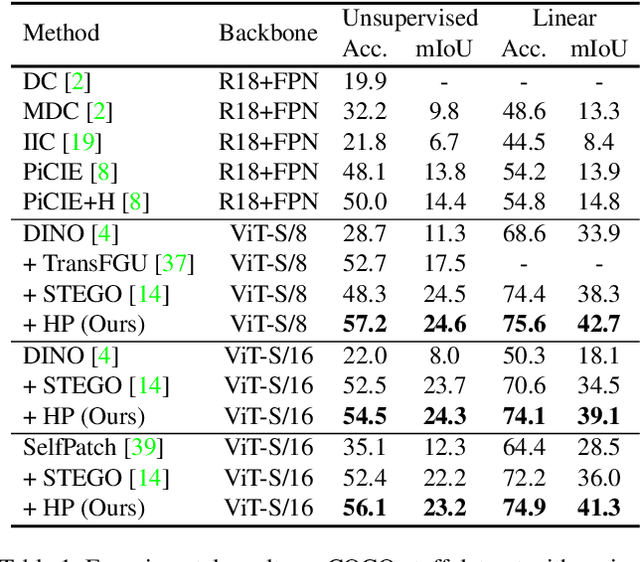
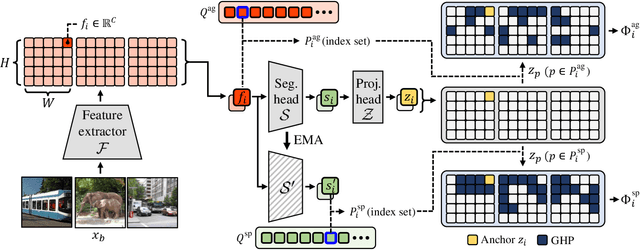
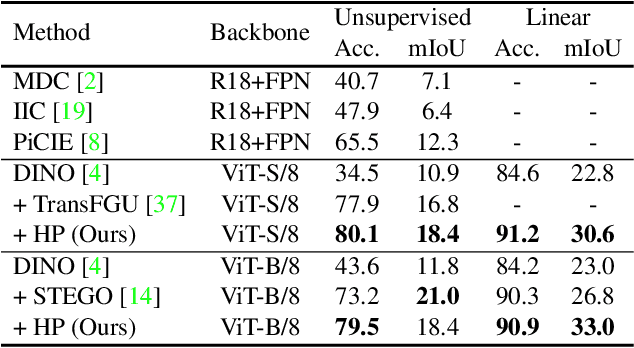
Abstract:Dramatic demand for manpower to label pixel-level annotations triggered the advent of unsupervised semantic segmentation. Although the recent work employing the vision transformer (ViT) backbone shows exceptional performance, there is still a lack of consideration for task-specific training guidance and local semantic consistency. To tackle these issues, we leverage contrastive learning by excavating hidden positives to learn rich semantic relationships and ensure semantic consistency in local regions. Specifically, we first discover two types of global hidden positives, task-agnostic and task-specific ones for each anchor based on the feature similarities defined by a fixed pre-trained backbone and a segmentation head-in-training, respectively. A gradual increase in the contribution of the latter induces the model to capture task-specific semantic features. In addition, we introduce a gradient propagation strategy to learn semantic consistency between adjacent patches, under the inherent premise that nearby patches are highly likely to possess the same semantics. Specifically, we add the loss propagating to local hidden positives, semantically similar nearby patches, in proportion to the predefined similarity scores. With these training schemes, our proposed method achieves new state-of-the-art (SOTA) results in COCO-stuff, Cityscapes, and Potsdam-3 datasets. Our code is available at: https://github.com/hynnsk/HP.
Task Discrepancy Maximization for Fine-grained Few-Shot Classification
Jul 04, 2022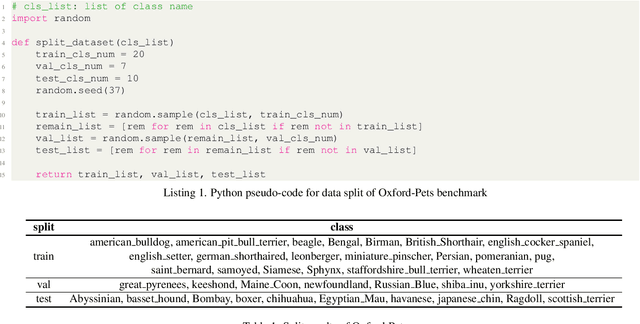

Abstract:Recognizing discriminative details such as eyes and beaks is important for distinguishing fine-grained classes since they have similar overall appearances. In this regard, we introduce Task Discrepancy Maximization (TDM), a simple module for fine-grained few-shot classification. Our objective is to localize the class-wise discriminative regions by highlighting channels encoding distinct information of the class. Specifically, TDM learns task-specific channel weights based on two novel components: Support Attention Module (SAM) and Query Attention Module (QAM). SAM produces a support weight to represent channel-wise discriminative power for each class. Still, since the SAM is basically only based on the labeled support sets, it can be vulnerable to bias toward such support set. Therefore, we propose QAM which complements SAM by yielding a query weight that grants more weight to object-relevant channels for a given query image. By combining these two weights, a class-wise task-specific channel weight is defined. The weights are then applied to produce task-adaptive feature maps more focusing on the discriminative details. Our experiments validate the effectiveness of TDM and its complementary benefits with prior methods in fine-grained few-shot classification.
* Accepted to CVPR 2022 as an oral presentation. Code is available at https://github.com/leesb7426/CVPR2022-Task-Discrepancy-Maximization-for-Fine-grained-Few-Shot-Classification
 Add to Chrome
Add to Chrome Add to Firefox
Add to Firefox Add to Edge
Add to Edge